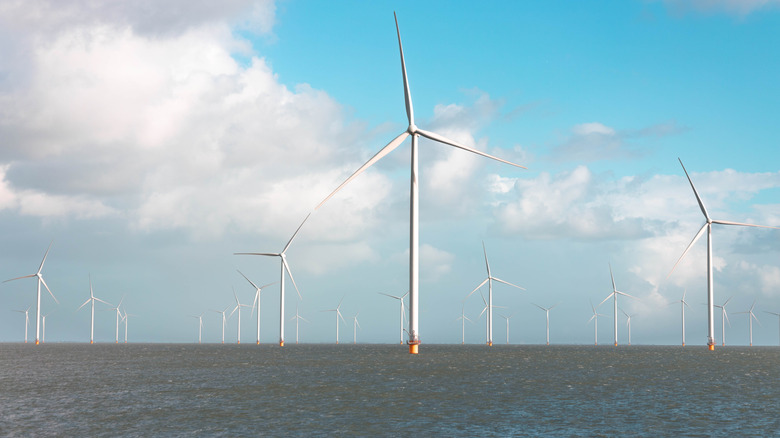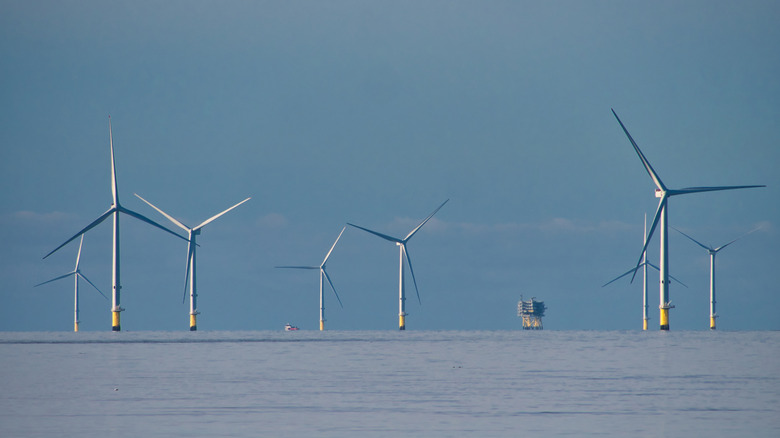How Big Is The Largest Wind Turbine In The World & How Much Electricity Can It Produce?
If you have ever seen a wind turbine in action, or simply being transported, you have an idea as to how massive they are. But have you ever wondered how big these things get in terms of sheer numbers? Looking at data from the U.S. Department of Energy, the average hub height of land-based wind turbines have steadily increased over the years (along with concerns surrounding their health effects). As of 2023, with an average hub height of 103 meters, the average land-based wind turbine in the U.S. is taller than the Statue of Liberty.
However, to witness the true behemoths among wind turbines, we need to travel several miles offshore. Out at sea, not constrained by transportation challenges, these turbines get truly massive. As of 2024, the largest offshore wind turbines in the U.S. included the 13-megawatt GE Vernova Haliade‑X installed (but subsequently destroyed) off the coast of Nantucket and the smaller 11-megawatt Siemens Gamesa SG 11.0‑200 DD wind turbines installed at the South Fork Wind Park. While these are among the largest wind turbines installed in the U.S., how do they compare to the largest wind turbines globally?
As of 2025, there are several contenders for the world's largest wind turbine in terms of power generation capacity. Notable ones include the 18-megawatt CSSC H260-18.0MW from China, the 20 megawatt MySE 18.X‑20 MW from China, the 21.5 megawatt Siemens SG 21‑276 DD from Europe, and the 26-megawatt Dongfang DEW 26 MW‑310. While these models top the charts in terms of capacity and size, they are yet to be made operational and remain in their prototype and testing phase. If commercially deployed wind turbines are what you're seeking, the most powerful model as of 2025 is the 15-megawatt Vestas V236‑15.0 MW.
The largest wind turbines in the world compared
With a capacity to generate 15 megawatts of power, the Vestas V236‑15.0 MW is the largest and most powerful wind turbine as of 2025 to have been commercially deployed. It features blades that are 115 meters (378 feet) tall and boasts a rotor diameter of 236 meters (774 feet), giving it a swept area of 43,742 square meters (470,834 sq feet).
Slightly larger than the Vestas wind turbine is the 18 megawatt CSSC H260-10.0MW, which boasts a hub height of 150 meters (492 feet), rotors that measure 130 meters (426 feet), giving it a total diameter of 260 meters (853 feet), and an effective swept area of 51,472 square meters (554,040 sq feet).
Then, there is the 20 megawatt Mingyang MySE18.X-20MW turbine which has a rotor diameter ranging between 260-292 meters (853-958 feet), and a swept area of 66,966 square meters (720,816 sq feet).
As for the Siemens SG 21‑276 DD, this model is rated to produce 21.5 megawatts of electricity with its 135-meter (442 meter) blades and a 276-meter (905 feet) diameter. It boasts a massive swept area of 60,000 square meters (645,834 sq feet)
A 26 megawatt wind turbine developed by Dongfang Electric Corporation is the largest wind turbine ever as of 2025 with a hub height of 183 meters (600 feet), While not officially confirmed by Dongfang, it is reported to feature 150-meter (492 feet) blades and boasts a rotor diameter of 310 meters (1017 feet). It also has a claimed swept area of 75,477 square meters (812,427.67 sq feet).
Just like with solar panels, it is interesting to note how Chinese firms are slowly dominating the wind turbine space, setting the stage for even bigger models as competition intensifies.

